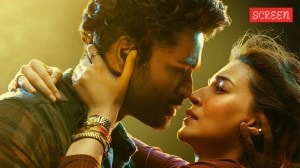Stay updated with the latest - Click here to follow us on Instagram
Strife Style
Every other profession has a dress code except journalism
Last week,I watched the absolutely ghastly film,Satyagraha. With a star-studded cast and being about the very topical anti-corruption movement,it sounded very promising. Instead,the film turned out to be a preachy tale of greed and righteousness about as far from entertainment as its possible to go. But what I noticed most in those excruciating and endless three-plus hours was the wardrobe and look of the crusading journalist in the film played by Kareena Kapoor Khan.
Yasmin (Kareena) wears the same kind of heavy kajal she wore in a period film many years ago,the dud Asoka. While reporting from the hot and arid heartland of Madhya Pradesh,she is perpetually draped in a scarf and chunky silver jewellery,worn with kurtas and jeans. These are the cliched hallmarks of dressing for all Indian journalists (at least according to Bollywood stylists).
Many years ago,when Preity Zinta played a reporter in a war zone in Lakshya,she went on record saying she deliberately cultivated a rugged,masculine look with short cropped hair,mismatched clothes and chewed-up finger nails. Apparently,journalists are not entitled to a sense of vanity,especially when theres a war going on.
Lawyers wear black jackets,doctors wear white coats and corporate-types wear suits. Scribes wear what they like. While journalists are rarely hired for their sartorial instincts,there is a long prevailing myth that they are uniformly scruffy and disheveled and must be so,in order to be taken seriously. This is when,internationally,many media houses are imposing dress codes for staff.
Last year,Halifax Media,a regional newspaper group in the US,banned jeans in the newsroom,irrespective of whether the job required you to be on the field or sit in the office and type all day. BBC anchors and reporters routinely come under scathing criticism from viewers who have been known to protest when they find their just off a beach look,inappropriate.
In India,a whole generation of scribes in the last 15 years has wilfully remained indifferent to the diktats of fashion,choosing the same tired paisleys on soft cotton,cleverly marketed by Fabindia and Anokhi as ready-to-wear. Mercifully,the younger lot of journalists have somewhat abandoned these stores for the more universal appeal of international chains such as Mango and Zara.
While no one is expecting journalists to set fashion trends,its important for clothes to reflect some level of seriousness,or at least not cause any comment for being wrong for the occasion. Broadcast journalists are generally held up to a higher standard of dressing,but very often,its still just a couple of notches above student attire. Thick necklaces or dangling earrings are distracting on screen,and with Indian women especially,jewellery seems to wear them rather than the other way around. There is an age for oxidised silver made Tibetan style,and its not your late30s. What looks cute on a college kid looks juvenile on a senior correspondent.
In Madras Cafe at least,actor Nargis Fakhri (also playing a journalist in a strife-torn area) is dressed right,reflecting how many international female journalists dress today in camouflage pants,comfortable boots and casual tank tops. Except the movie is set in the early 90s and she looks straight out of 2013. Whatever the time frame,its time to bid goodbye to the khaadi-clad reporter on screen at least,if not in real life.







